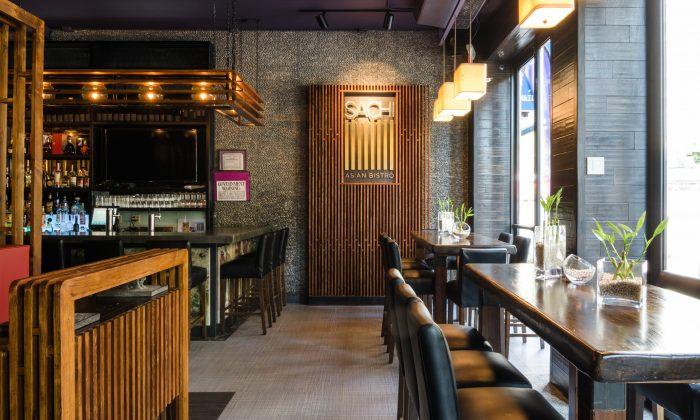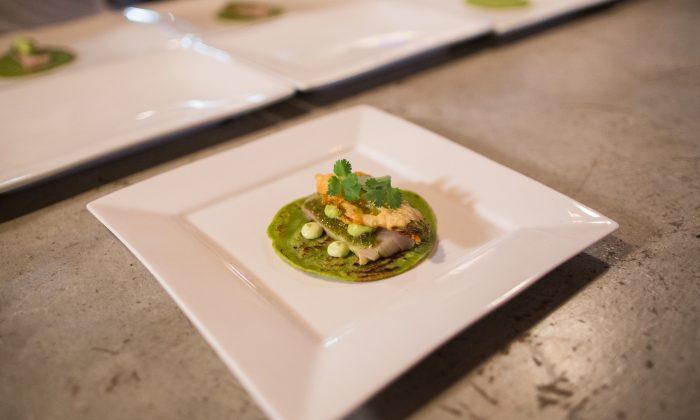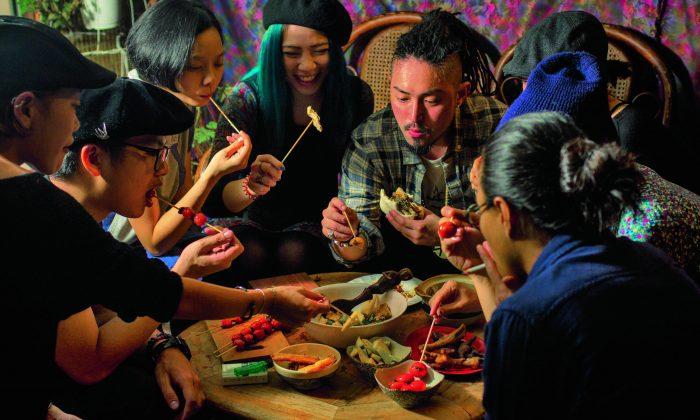Open in September in Murray Hill, Sachi finds inspiration from a variety of Asia’s cuisines. Andy Yang, of Rhong-Tiam, and Pichet Ong have been tapped to create the menu.

The results of the collaboration are interpretations of dishes with an eye to health, with bold flavors first and foremost, for the most part, and affordability.
Some guests have been overheard comparing Sachi to Hakkasan across town. Sachi does have an upscale ambiance with its spare, clean aesthetic, though it is less expansive in feel.
The red banquettes lining the booths are comfortable, and the dark wood panels create intimate spaces. It’s easy especially for small groups to converse in the booths. I especially liked the large booth at the back of the restaurant. Along the back wall, underneath the sculptures of two dragons, an imperceptible veil of water runs down the wall, creating a soothing sound.


The starkest contrast to Hakkasan is the dramatic price difference. A meat or seafood entree at Sachi, say steamed seasonal fish, costs about $16.
Dim Sum
The dim sum looks deceptive. The prospect of small bites seems harmless enough, but there is a cumulative effect. So be forewarned, if you start with some dim sum (and it is tempting) and still plan for more dishes afterward, go easy.

That’s because Sachi’s dim sum, made to order, is superlative. Ordering from a pushcart at traditional dim sum venues has its charms, like the experience of choosing from a pushcart (and maybe, if you’re like my family, going hungry until what you want shows up).
But there is a huge benefit to dim sum dishes made to order. They hit your table piping hot, and when it comes to fried items, anything less than piping hot is no good.
The stuffed eggplant appetizer (two for $9) is a good example. With a delicious filling bursting with shrimp, pork, mushrooms, scallions, and water chestnut, it is dipped in a thin batter and fried to an impossible crispness.

The Dim Sum Sampler (six pieces for $15) lets guests try a few items: the mushroom dumplings, crab shumai dumplings, and charsui duck buns.
It’s hard not to admire the skill of the dim sum chef. The mushroom dumpling skin is so thin it’s translucent, enveloping enoki, oyster, and shiitake mushrooms, while the crab shumai, which so often falls apart when picked up, remained firmly together, cradled tightly in a thin bean curd wrap. The soft, pillowy buns are filled with a marmalade of charsui duck and shallots—an ode to comfort food.
An innovative touch is the dipping sauces. You are presented with three sauces. There’s a spicy one, made of sambal and gochujang (in a mash-up of Indonesian, Malaysian, and Korean influences), and the one I came back to most often. There’s also a classic soy-sauce-and-vinegar dipping sauce, and lastly, rau ram, a coriander-ginger scallion oil of Vietnamese origin, the favorite of my dining partner.
Highlights
The menu has a lot to choose from, with a number of highlights. Among them, the Lion Head Meatballs, that Shanghai classic, are light and airy, much like biting into a cloud ($14).
Another highlight is the aptly named Oink Oink Oink Fried Rice. It takes fried rice to a new level, with plenty to love for pork lovers: pork belly, sausage, and Chinese sausage, using not regular white rice, but black rice ($14). It provides a rich, satisfying dose of umami.

Eel finds its way out of sushi and into tacos, proof that eel can be good no matter what the carrying carb may be, as long as it’s accompanied with a worthy sauce ($8); here spicy miso and soy barbecue sauce do the honors.

Side dishes provide a welcome foil to the savory. They are great values, and at their prices, get you generous portions where elsewhere you might get little more than tapas-sized morsels.
Rojak ($7) provides sweet, tangy, and spicy (not though as spicy as some might like) notes, with pineapple, jicama, peanuts, and sambal.

Oshitashi ($6) with mustard greens, radish, and seaweed, in an all-at-once creamy and earthy sesame dressing gives pause to contemplate and slowly savor.

The only quibbles I had were with dishes that are still finding a footing in terms of their intensity. It’s been about three weeks since the restaurant opened and it’s trying to find a just-right middle-ground that will satisfy most customers, between the kitchen’s original rendition of the dishes, and what locals are asking for—and the latter seems to be, sadly, toned-down versions.
The Lemongrass Poussin ($14) looked beautiful, but had no hint of lemongrass when I tried it a week ago. I was told the original version had much more pronounced lemongrass flavor. Disclaimer: I may well have a near-inborn bias, with lemongrass and galangal being part of the universe of flavors I was raised on.

The Dan Dan Ramen ($15) had zero spice, despite a name that promises the zing and thrill of Sichuan peppercorn.
It may not be possible to make everybody happy in the end. What direction the restaurant decides to go will be an interesting one.
But there is still plenty to recommend, and the price can’t be beat.
Desserts
Other standouts include the desserts.
Chef Pichet Ong is in excellent form with his desserts—scrumptious, with excellent contrast of textures—the kind you don’t really want to share. Being a fan of crème brûlée, I fell for the Caramelized Ginger Custard ($10), the creaminess of the custard offset by the crackly brown crust and the crumbly graham crust on the side, while my friend preferred the Flourless Chocolate Cake with matcha cream ($10).


The cocktail list is also impressive. Mixologist Jason Walsh (who has worked at Monkey Bar, Bistro La Promenade, Bouley and Bea) has put in time to offer combinations that he couldn’t find anywhere else. The cocktails include, for example, the green Jade Lantern (vodka, matcha green tea, lemon juice, and mint leaves) and a Galangal Sour (blended scotch, fresh pressed lemon juice, galangal root, kaffir lime, egg white).

Lunch was introduced on Wednesday. There are plans to introduce pushcarts for a dim sum brunch. I plan to go back, so I hope they manage to keep the dim sum piping hot.
Sachi
713 Second Ave. (at 38th Street)
212-297-1883
SachiNYC.com
Hours
Monday–Friday noon–3 p.m; 5 p.m.–11:30 p.m.
Saturday noon–11:30 p.m.
Sunday noon–11 p.m.







Friends Read Free